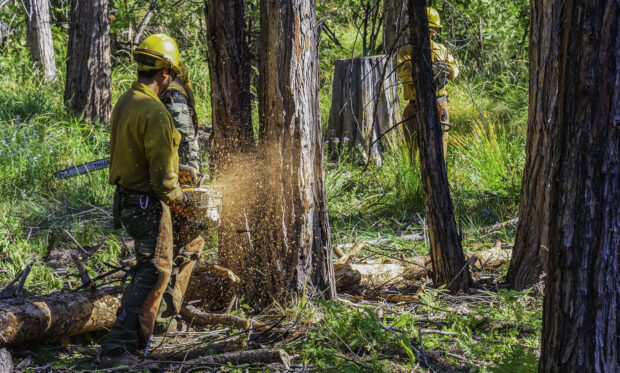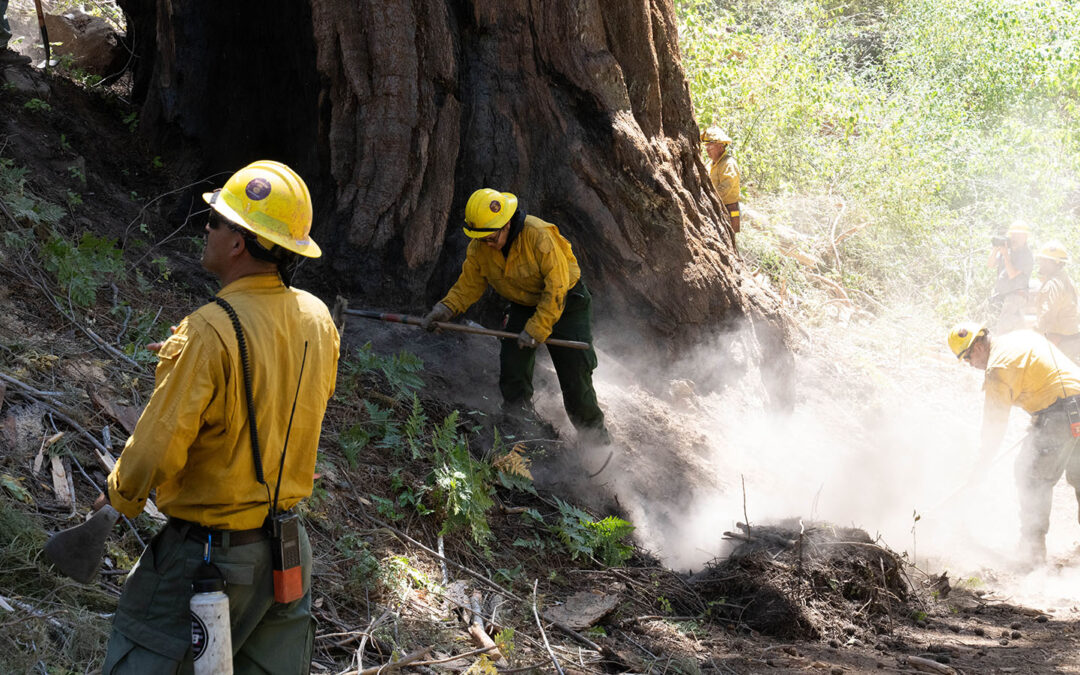Giant sequoias are the most massive trees on Earth. They are also among the oldest, with the age of some trees exceeding 3,000 years. The trees grow in about 70-80 groves that cover less than 30,000 acres on the western slopes of California’s Sierra Nevada. In this fireprone environment, giant sequoias’ thick, fibrous bark — up to 2 feet thick — provides insulation against fire, and the branches of large trees grow high enough above the ground to avoid the flames of most wildfires. In fact, these “big trees” (as John Muir called them) need fire for their seeds to germinate.
Their size and longevity are a testament to the trees’ resilience, so the loss of an estimated 13-19% of mature giant sequoias to fire in just two years alarmed scientists, conservationists, and land managers, who cite human-induced climate change and a century of forest mismanagement as factors in such catastrophic fires.
In July 2022, Forest Service Chief Randy Moore announced the Giant Sequoia Emergency Response to counter the threat. His statement reads, “Without urgent action, wildfires could eliminate countless more iconic giant sequoias. … This emergency action to reduce fuels before a wildfire occurs will protect unburned giant sequoia groves from the risks of high-severity wildfires.”
Encompassing approximately 13,377 acres and 12 giant sequoia groves, the emergency action will expedite environmental reviews and allow the Forest Service to “remove surface and ladder fuels that present the greatest wildfire risk and include … mechanical removal of trees, … pulling duff away from the base of large giant sequoias and prescribed burning.”
Of the three recent fires to burn into sequoia groves, the 2020 Castle Fire did the most damage, killing an estimated 7,500-10,600 large sequoias (those with trunk diameters of 4 feet or more) in the Sequoia National Forest and Sequoia National Park. At a December 2022 meeting of the Giant Sequoia Lands Coalition, Jessica Morse, deputy secretary with the California Natural Resources Agency said the recent fires were far worse than the fires of 1297.

In the aftermath of the Windy Fire, giant sequoia seedlings surround the remnants of burned trees on the Trail of 100 Giants in the Sequoia National Forest (Forest Service photo).
The 1297 fires occurred during the Medieval Warm Period, which produced multi-decade droughts in the West, including one that lasted about 60 years. Between this medieval drought era and the arrival of European colonists, tree-ring data show that low- to moderate-intensity fires burned through sequoia groves every 6-35 years. National Park Service information indicates this beneficial pattern changed after about 1860, “probably a result of intensive sheep grazing … and a decrease in fires set by Native Americans, followed by fire suppression by government agencies,” including the Forest Service.
Scientists studying sequoia groves on National Park lands determined that giant sequoia populations were “stable or increasing” from 500 B.C. through the 1800s, but in the 1900s, “there was a massive failure of giant sequoia reproduction.” Giant sequoias are among the first trees to establish after a disturbance, and without fire, “conditions did not favor growth and survival of young sequoias.” Before the arrival of European settlers, “successful establishment of mature sequoias depended on fires intense enough to kill the tree canopy in small areas, allowing enough light for young sequoias to grow and thrive.” The centuries-old fire regime helped maintain the balanced forest ecosystem that sequoias need to flourish, thinning smaller trees and removing highly combustible fine fuels from the forest floor. Without fire, sequoia seeds stopped sprouting, and the likelihood of more severe fires increased.
In the late 1960s, the National Park Service implemented a prescribed burning program in giant sequoia groves “to reduce the hazardous fuel buildup, hoping to avoid catastrophic wildfire, while at the same time restoring fire to a more natural role.” In 1987, the Park Service formed a panel to evaluate the fire management program in the sequoia-mixed conifer forests of the Sierra Nevada. The report affirmed “a continuing need for fire management programs in these ecosystems.”
In 1998, the Forest Service published a report on the effects of prescribed fire in giant sequoia groves in Sequoia and Kings Canyon national parks. The report documents the results of eight prescribed fires over a 9-year period, including significant increases in soil nutrients, especially available nitrogen, in the aftermath of the fires, benefiting seedlings and mature trees alike. The report also documents “complete consumption of the litter and duff … over most of the area,” generating “instantaneous lethal temperature (150°F) in the soil and cambium” of some giant sequoia and sugar pine trees. (Cambium is a thin layer of tissue important for new cell generation and plant health.) While the resulting root and cambium damage caused a 67% mortality rate among sugar pines, no deaths occurred among giant sequoias.
Clearly, fire plays a crucial role in maintaining healthy stands of giant sequoias. According to Alexis Bernal, a researcher with the University of California at Berkeley, Sierra Nevada forests typically had about 20 trees per acre prior to 1860, but fire suppression policies have produced forests with as many as 120-160 trees per acre. In addition to more fire, Bernal insists that extensive logging is needed to restore the forest ecosystem. “We want to get a forest back to what a fire-resilient landscape would look like,” she said. “You would have to take out a lot of these trees to do that.”
The Giant Sequoia Lands Coalition’s 2022 Progress Report highlights “restoration treatments” on 4,257 acres in 36 groves — a preview of projects that align with Bernal’s strategy and which will benefit from the $5.5 billion budget increase bestowed upon the U.S. Forest Service by the Infrastructure Investment and Jobs Act (IIJA). The progress report documents member activities that include “salvage logging,” “mechanical treatment,” and “hazard tree removal.” Coalition members include the Forest Service, the National Park Service, the California Department of Forestry and Fire Protection, and California State Parks.
John Muir Project Director Chad Hanson, a forest ecologist, acknowledges the need to return fire to the landscape, but he sees mechanical thinning as an excuse to continue commercial logging of public lands. mechanical thinning as an excuse to continue commercial logging of public lands. He called the work of Bernal “scientific fraud” that uses underestimated tree densities as a baseline.
Bernal and others, like Forest Service Research Forester Mark Finney, accuse Hanson of “agenda-driven” science. Nonetheless, Hanson was joined by 200 of his peers in signing a letter to President Joe Biden discouraging funding for these types of projects in the IIJA. In spite of the letter, the legislation established a new exemption to allow trees to be cut for fuel breaks, which are of dubious benefit according to research by Finney.
Hanson sees the recent megafires as a historical correction. He believes sequoia mortality has been far less than official estimates and that new trees can regenerate despite increasing wildfire intensity.
Finney asserts, “The only way to maintain a forest in a low-hazard condition is through repeated burning … but you can’t introduce fire without some mechanical treatment first. … You can’t restore structure without mechanical means.”
Meanwhile, the Sequoia Coalition is promoting additional legislation to expedite “fuel treatments” in sequoia groves. The bipartisan Save Our Sequoias Act, introduced by Kevin McCarthy (R-Calif.), would expedite fuel treatments in part by further bypassing environmental laws.

A sawyer cuts a standing dead tree in the Indian Basin Grove in the Sequoia National Forest as part of the Giant Sequoia Emergency Response (Forest Service photo).


